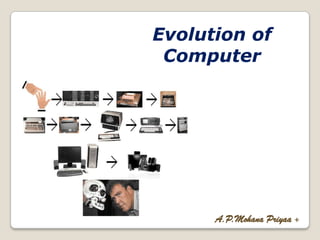
02. History - Evolution of Computers
- 2. Used in Asia for a Long time (2000-3000 BCE) Also known as “SOROBAN” perform addition and subtraction Wooden rack holding two horizontal wires with beads strung on them. Rules memorized by the user Regular arithmetic problems can be done Abacus
- 3. NAPIER’S DEVICE John Napier a Scottish Mathematician Set of eleven animal bones later it was replaced by rod Number marked on them, they placed side by side Products and quotients of large numbers could be obtained
- 4. SLIDE RULE Invented in 17th century based on the emerging work on logarithms by John Napier Perform all arithmetic & trigonometric function Final value can be straight away read on scale
- 5. PASCAL’S CALCULATING MACHINE (PASCALINE) Blaise Pascal a French mathematician developed mechanical calculating machine called Pascal’s calculating machine in 1642 CE First real desktop calculating device that could add and subtract. Construct of set of toothed wheels or gears. Each wheel having 0 through 9. Arithmetic operation performed by turning these wheels. Concept still seen in conventional electric meter and taxi meter
- 6. LEIBNITZ’S IMPROVED PASCAL MACHINE Pascal machine perform only addition and subtraction operation Pascal machine was improved in 1673 CE Introduced wheel could perform multiplication, division and square root operation.
- 7. PUNCHED CARD Punched cards were first used around 1725 by Basile Bouchon and Jean-Baptiste Falcon and greatly improved by Joseph Marie Jacquard in 1801. Control textile looms, invented punched cards. Cards with holes were used to make attractive design on fiber Presence and absence of punched hole represented two states for raisers or lowers of wrap thread
- 8. CHARLES BABBAGE’S ENGINES. Charles Babbage (1792-1871) made a machine called Difference Engine. Evaluate accurate algebraic expression and mathematical tasks up to 20 decimal places, This machine is also called as Babbage's difference engine, Later adopted by insurances companies for computing life tables. Later modified the device as Analytical Engine.
- 9. If had memory unit, operation arithmetic operators. Produced the output in punched card format. Parts and working principle of Analytical Engine similar to today computer. Charles Babbage is called “Father of Computer”
- 10. HOLLERITH’S MACHINE Dr.Herman Hollerith of U.S.A, working in U.S.A as census offices Developed a card reading machine and used punched cards for tabulating and calculating data, Data was being compiled and analyzed.
- 11. MARK-I DIGITAL COMPUTER All calculating machines are invented basically mechanical machine. First electro-mechanical computer developed by Howard aiken. Used Hollerith's punched cards and principle of computer stated by Charles Babbage Automatically perform a sequence of arithmetic operators. Huge mechanical calculator which occupied several norms. Inside several miles of electrical wires and electro mechanical relays and mechanical counter for arithmetic calculations
- 12. FIRST ELECTRONICS COMPUTER (ABC) Atanasoff-Berry Computer Dr. John Atanasoff and Clifford Berry developed first electronic computer. It is called as ABC. Use vaccum tubes for storage , arithmetic and logical function. Special purpose used to solve simultaneous equation. It could perform 500 addition or 350 multiplication in one second.
- 13. Electronic Numerical Integrator And Calculator (ENIAC) Electronic computer, Developed by Prof. Presper Eckert and John Mauchly. Produced in 1940 for U.S.army It used 18000 V.T 70000 resistor 10000 capacitor and 60000 switches (27 tons) Occupy 5000 s7 suet of space. Perform 300 multiplication/second Fastest machine. ENIAC was considered a significant development because the speed was first experience with ENIAC.
- 14. Electronic Discrete Variable Automatic Computers (EDVAC) First electronic stored program computer. Electronics computers developed in 1949. EDVAC different form ENIAC. 1.use of binary and electronic arithmetic operators. 2.Internal storage of instructions were written in digital forms.
- 15. Electronics Delay Storage AutomatiC (EDSAC) Developed by group of scientist headed by prof.mauriee willies Using EDSAC , addition operation was accomplished in 1500 microseconds and multiplication operator in 4000 micro second
- 16. Manchester Mark 1 Small experimental computer. Performs operation based on stored program. Designed Manchester university by a group of scientist headed by Prof. M.H.A Newman. Storage capacity of only 32words, each of 31 binary digits. Limited to stored data and instruction.
- 17. UNIVersal Automatic Computer I (UNIVAC I) Second commercial computer produced in the United States. Made by the inventors of the ENIAC. UNIVAC –I is first computer used for business in 1954 The machine was simply known as "the UNIVAC“
- 18. MICROPROCESSOR Microprocessor chip INTEL 4004 was developed in 1969 by INTEL. perform only few instruction and very small amount of data. 1971 INTEL 8008 MP was developed. Foundation for development of personal computer(pc).
- 19. 19 SoC A System on a Chip or System on Chip (SoC) is an integrated circuit (IC) that integrates all components of a computer or other electronic system into a single chip Integrates almost all components into a single silicon chip. Along with a CPU, an SoC usually contains a GPU, memory, USB controller, power management circuits, and wireless radios. Whereas a CPU cannot function without dozens of other chips, it’s possible to build complete computers with just a single SoC ◦ http://en.wikipedia.org/wiki/System_on_a_chip
- 20. PERSONAL COMPUTERS (PC) First PC (with MP) developed in 1974. In 1977 first successful micro computer (PC) developed by a young technician named Steve Wozniak. This was called the computer Apple-1
- 21. Created by the 1991 Apple–IBM– Motorola alliance, known as AIM. Performance Optimization With Enhanced RISC – Performance Computing (POWER PC)
- 22. Pentium is a brand used for a series of x86-compatible microprocessors produced by Intel. Pentium CPU based computers were most commonly used Computers few years ago Pentium
- 23. Intel Core is a brand name that Intel uses for various mid-range to high-end consumer and business microprocessors. In general, processors sold as Core are more powerful variants of the same processors marketed as entry-level Celeron and Pentium Core
- 24. All the best!
